Accessories for a video camera in a surveillance system
In the modern world, video surveillance systems are used as a means of ensuring the security of residential and commercial facilities. The list of elements of the system in addition to video cameras includes the following components: cable, power supplies, lights, receiver and other equipment, depending on the purpose and complexity of observation.
Content
- 1 Selection of cable for video surveillance
- 2 Varieties and operational features of power supplies
- 3 Aspects of the use of infrared illumination for video surveillance
- 4 Functions of the receiver in the organization of video surveillance systems
- 5 When a network switch is required for video surveillance
Selection of cable for video surveillance
The cable in the surveillance system provides:
- transmitting a signal from the camera to a computer or other recording device;
- power supply of used devices;
- communication with external accessories.
The ability of the video surveillance system to perform the assigned tasks depends on the choice. For security reasons, several options are used:
- coaxial cable;
- combined cable;
- twisted pair.
The required sample is selected depending on the type of the mounted surveillance system, which can be analog or digital, respectively, the types of cameras used in its basis. Cable for analog video cameras can be coaxial, also called radiofrequency or combined (radio frequency + electric).
Coaxial cable features
The main components of the conductor are shown in a schematic illustration.
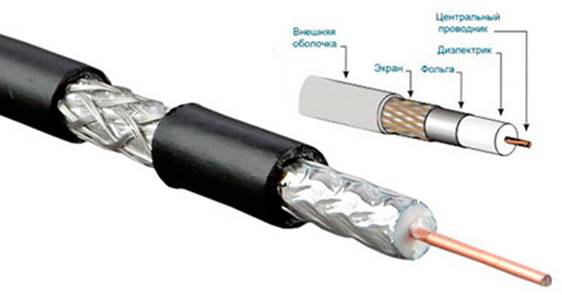
The central copper or aluminum wire can be single-core or consist of several cores of small diameter (multi-core). Dielectric in various versions can be made of foamed plastic, Teflon or polyethylene. Shield braid made of aluminum or copper foil and thin wires,It protects the signals passing through the cable from interference and loss.
Released several modifications coaxial cable:
- for outdoor installation with a black shell resistant to moisture and dirt, temperature changes;
- for internal installation with a shell of gray or white shades;
- trunk cable (cable).
Also produced coaxial conductors differ standard impedance:
- to transmit radio signals 50 Ohms;
- for transmitting 75 ohm video signals.
The table below presents the most popular product modifications.
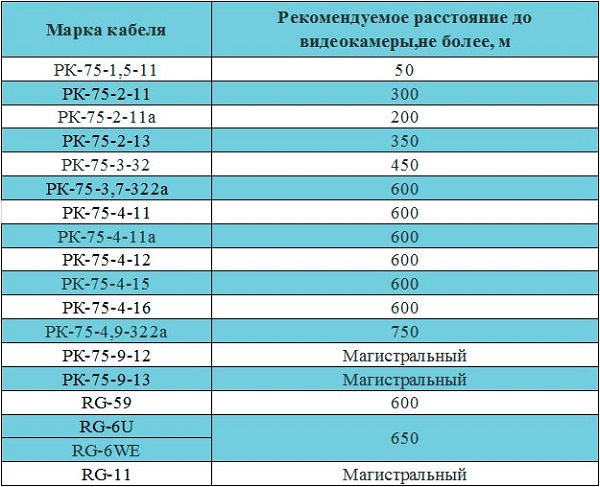
For video surveillance, it is important that the central conductor and the sheath of the conductor are made of copper. This cable transmits a signal with a minimum of losses.
There are other characteristics that you should pay attention to when choosing.
- Product flexibility important when the installation of the system involves multiple bends when laying the cable. In this case, you should choose the multicore conductor - more flexible in comparison with the single-conductor.
- Shielding braid quality - protection from interference and possible losses depends on it.
- The diameter of the dielectric shell.
- The attenuation rate of the signal.
This type of conductor is used exclusively for signaling.. When installing the system, it is important to determine the power of the cameras. There are two options here:
- laying the appropriate electrical cable to supply voltage to all cameras;
- use of a combined cable.
Features of the combined conductors (KVK)
KVK is a combination in a single shell coaxial and power supply conductors.
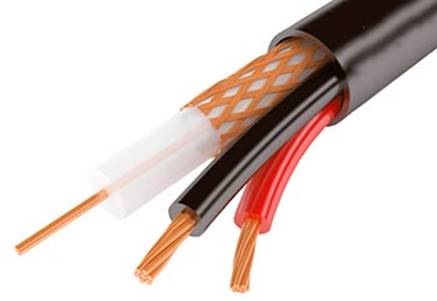
Application of the product is appropriate in the installation of video surveillance systems in cases where the power and signal transmission from the camera is carried out from a single point. Laying additional voltage wires, as described above, is not required.
Manufacturers produce varieties of combined conductors with additional conductors for connecting external devices to the camera (microphone, motion sensors, electrically-controlled swivel bracket, etc.).
Product modifications are marked depending on the intended use.
- KVK-P is designed for mounting outdoor video taping. It is weather resistant, can be used for overhead lines.
- CCASM is designed to transmit video and audio signals.
Together with the letters in the marking numbers are used, which indicates the number of additional insulated wires hidden in a single sheath.
Cable for mounting a digital video surveillance system
For installation of systems using IP cameras, and communications of electronic devices into a single network, twisted pair is used. The overall presentation of the product reflects the schematic drawing.
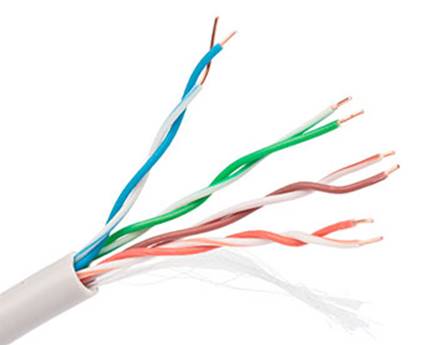
Depending on the design features, a twisted pair is marked with the following letter combinations.
- UTP - the simplest form of twisted pair, is an 8 pair of twisted insulated conductors in a single protective sheath. Product has no shielding braidIn this connection, it is unstable to electromagnetic interference. Not recommended for installation near wiring.
- FTP is distinguished by the presence of common to all pairs of foil screen. The cable is more resistant to interference, it can be laid next to the wiring. To preserve the foil shield, it is not recommended to allow bends exceeding the minimum allowable value (8 times cable thickness).
- STP is different common copper shielding braid and the presence of foil shield on each copper conductor. Recommended for installation of a system covering a large area or in the presence of multiple sources of interference.
The choice of cable depends on the technical conditions of installation of a surveillance system on a specific object.
Varieties and operational features of power supplies
The performance of the surveillance system depends on the quality of the power supply of the cameras. For a stable supply of current desired power and voltage power supply units are used. These devices are classified by their output voltage:
- constant voltage of 12 V;
- constant voltage 24 V;
- AC voltage 220 V.
Depending on the form factor, the devices are divided into three types.
- Traditional plastic power supply 12 in with built-in cord and plug for powering one camera.
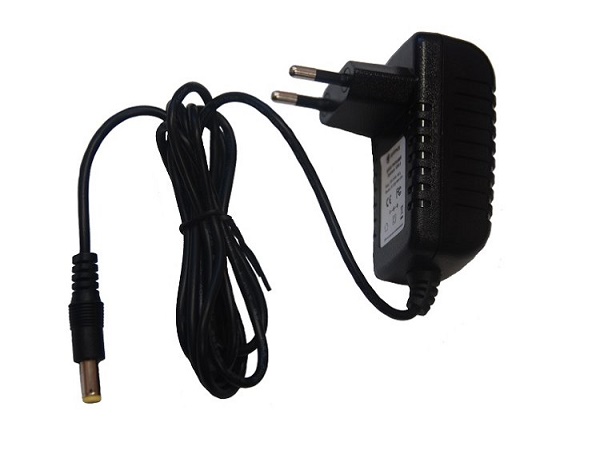
- Power supply in a perforated metal case. These are more powerful devices with a terminal block for connecting electrical power cords to several devices and a voltage regulator.
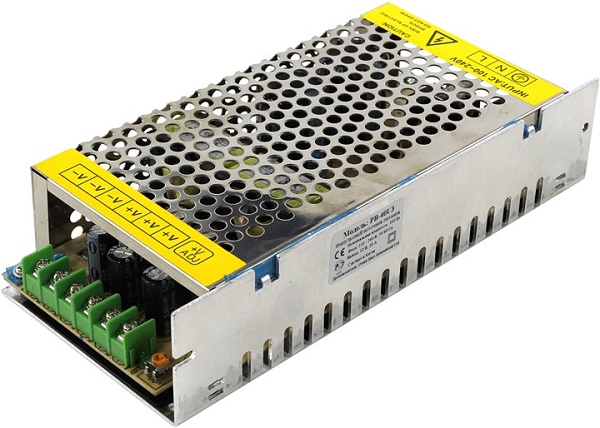
- The metal protected guard with a doorwhere the location of the battery is provided, allowing the source to supply voltage for a short time when the main power supply is disconnected. It turns out uninterruptible power supply (UPS)
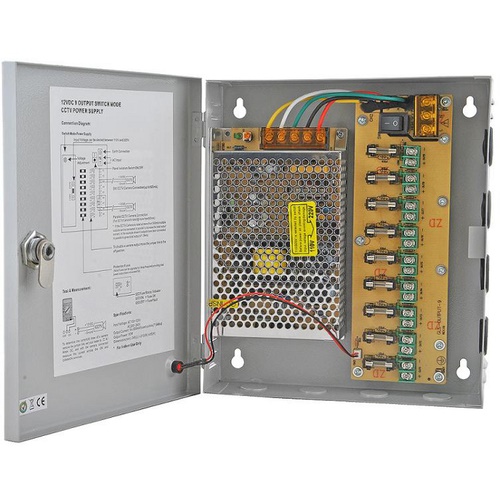
To provide power to an outdoor video surveillance system, it is recommended to use an alternating power source in a form factor. The block is selected on the basis of calculations based on the number of video cameras serviced, the size of the territory and other factors.
For the organization of observation in a small office through several cards, a perforated power supply with a sufficient number of power connectors is suitable. To provide power to one camera, a standard voltage source supplied with the device is sufficient.
Aspects of the use of infrared illumination for video surveillance
Additional lighting of outdoor video cameras in the dark is a logical but not optimal solution. Conventional lamps burn out, they are easy to break. Infrared lights for video cameras are a modern and ergonomic option to monitor low-lit areas.
IR illumination is invisible to the human eye, but is well fixed by cameras, which creates the necessary conditions for reliable protection of objects. Some models of video cameras are equipped with built-in IR illumination.

Also available external sources of infrared radiation for lighting CCTV cameras. By design solutions, IR illuminators are divided into:
- halogen lamps with IR filters;
- devices based on infrared LEDs.
Halogen IR illuminators work effectively, their range of illumination is more than 100 meters, while consuming a lot of electricity. Also, due to the low unreliability of halogen lamps, the service life of short-lived devices. IR diodes for backlighting durable, compact in size, less energy consuming, but their radius of action is significantly inferior to halogen spotlights.
When choosing an infrared illumination, all requirements related to the observation of a particular protected object are taken into account.
Functions of the receiver in the organization of video surveillance systems
Video receivers for security systems are a receiver of digital signals, the task of which is to decode a digit into an image and its output on the screen of a monitor, computer, TV, or other device transmitting a picture. The following features distinguish the receiver for video cameras from other similar devices:
- the ability to receive video and audio signals via cable or via a wireless transmission system;
- the ability to receive, depending on the model, signals from several cameras (4-8);
- ensuring viewing of the shot video in real time;
- Easy connection to the monitor via USB cable.
Device cost depends on its functional set. Receivers, available at the price, are suitable for video protection of giving or a country house. Economy class devices are more functional, recommended for video surveillance in offices, small warehouses and retail outlets. For observation at large enterprises, trading floors, water parks, playgrounds,Restaurants require multifunctional receivers capable of transmitting images from multiple cameras to the big screen.
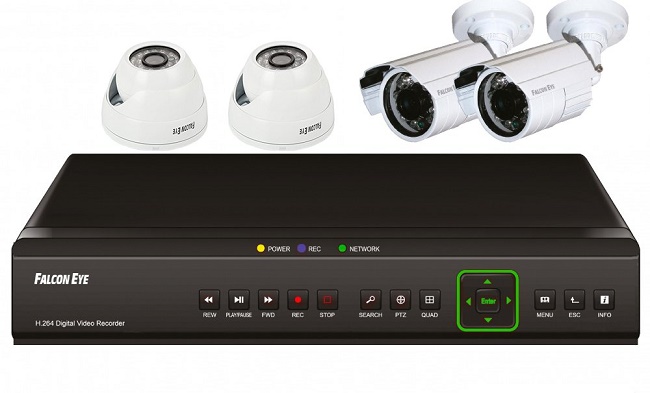
When a network switch is required for video surveillance
When to build from several electronic devices a single network so that they can exchange data, ip-switch is used. A surveillance system consisting of several cameras and other devices is a network, and the switch in it is an important link in ensuring stable operation.
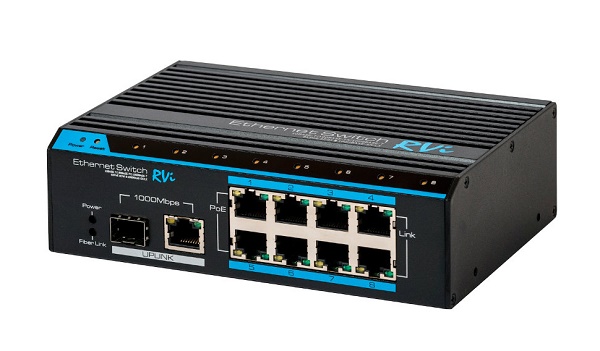
The choice of switch for ip-video cameras of a particular security system depends on a number of important technical characteristics.
- Bandwidth. This parameter determines the amount of digital information that a device can pass per unit of time through all its ports. On sale most common switches for connecting cameras with access control 10/100 Mb / s and 1 Gb / s. Insufficient throughput is fraught with periodic braking of the picture change.
- Number of ports. The parameter defines the maximum number of devices connected to the network.It is important that the multiport switch has high bandwidth.
- Form Factor and Purpose. Devices for outdoor installation are performed in a durable, protected from the negative effects of the body. The degree of protection must be at least IP66. For the interior there is no need for increased security requirements for the device. Users demand compact models with additional mounting hardware.
- Presence / absence of functions PoE, MDI / MDI-X.
The best ip-switch is the one that best meets the requirements of the security system of video surveillance of a specific object.

/rating_on.png)











